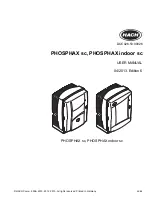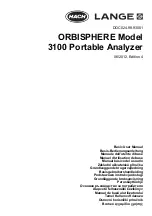
AM 334-01-502
44
II. Control Panels
The following pages contain schematic diagrams of the
control panel PC boards CB. . . which include slide controls,
switches and drawbars, and key contact boards KD. . .
which decode and route inputs from the key. boards and
pedals.
1. CB Boards
The control panel PC boards CB. . . work on a principle of
continuous polling of the control switches by the CPU on
master processor board MST 3, On, for example, CB 21
(Fig. 21), the parallel-out serial shift registers lC2, 7, 8, 9, 1
and 10 are clocked by peripheral output line pulses from the
CPU. The register outputs continuously and rapidly poll the
status of the control panel function switches.
A momentary switch closure results in a sense pulse, which
is applied to the CPU's data bus. This sense pulse occupies a
specific time slot in the CPU's sequence pro-gram and
instructs the CPU to initiate the function for that time slot.
The CPU, in turn, senses a serial data code to the appropriate
register set, designating the LED(s) to illuminate on the
panel switches.
2. Key Contact Boards
KD la (Fig. 25a)
The dynamic perception of keyboard action is possible
through the principle of time measurement. To accomplish
this, the spring contact for each key performs a normally
closed-to-normally open switching function. The. time from
the opening of the normally closed (rest) state of the contact
to the closing of the normally open (working) state is
measured electronically.
Every eight contacts are assigned to a matrix address. For
five octaves (61 keys), eight matrix addresses are necessary.
These matrix addresses are sequentially switched to ground
so that the statuses of the 61 contacts can be polled. The
speed at which the polling takes place is determined by the
setting of the code switch S1. (Note: "Reset" must be
pressed after any change in the code switch). If the polling
rate is very short, a key must be pressed quickly to achieve
maximum dynamic value.
The dynamic value is transferred to one of two 2-byte
parallel ports. The first port, 1C5, transfers data that
determines pitch values and whether a note should be turned
on or off. The second port transfers data determining the
dynamic value. When the dynamic value is entered, lC8a, a
flip-flop, toggles, releasing an FIRQ (interrupt request) shot
to the CPU.
During the port read cycle, the key (1C5) is read first
and the FIRQ appears in its highest bit (on IC4/pin
13). This tells the CPU which manual the FIRQ is for.
When this is determined, the dynamic value for that
manual is read and the flip-flop resets; In addition, the
FIRQ can be cancelled by the other flip-flop, IC8b.
1C7 handles the address decoding.
KD lb (Fig. 25b)
The circuitry of this board polls the pedal switching matrices
to determine pedal switch closures. Specific matrix schemes
are used according to organ type and these are selected by
jumpers Ju7 thru 14.
KD2/KD4
These extend the key contact matrices according to the
number of octaves (KD4 for 4 octaves, KD2 for 5 octaves).
Summary of Contents for DX 400
Page 1: ...AM 334 01 502 1 assembly manual Technical Data DX 400 500 AM 334 1st Edition ...
Page 2: ...AM 334 01 502 2 ...
Page 8: ...AM 334 01 502 8 Fig 3 Block diagram of the audio section ...
Page 10: ...AM 334 01 502 10 BACKPLANE BOARD MB 30 EDGE CONNECTOR PIN LAYOUT VIEWED FROM SIDE A ...
Page 11: ...AM 334 01 502 11 Backplahe board MB 30 plug layout ...
Page 13: ...AM 334 01 502 13 Fig 4 Plug in board PS 12 component layout and functions ...
Page 14: ...AM 334 01 502 14 Fig 5 Plug in board PS 12 schematic diagram ...
Page 16: ...AM 334 01 502 16 Fig 6 Plug in board AF 12 component layout and functions ...
Page 17: ...AM 334 01 502 17 This Page is Intentionally Blank ...
Page 18: ...AM 334 01 502 18 Fig 7 Plug in board AF 12 schematic diagram ...
Page 19: ...AM 334 01 502 19 ...
Page 21: ...AM 334 01 502 21 Fig 8 Plug in board DH 10 component layout and functions ...
Page 22: ...AM 334 01 502 22 Fig 9 Plug in board DH10 schematic diagram ...
Page 23: ...AM 334 01 502 23 ...
Page 25: ...AM 334 01 502 25 Fig 10 Plug in board EF 20 component layout and functions ...
Page 26: ...AM 334 01 502 26 Fig 11 Plug in board EF 20 schematic diagram ...
Page 27: ...AM 334 01 502 27 ...
Page 29: ...AM 334 01 502 29 Fig 12 Plug in board EF 19 component layout and functions ...
Page 30: ...AM 334 01 502 30 Fig 13 Plug in board EF19 schematic diagram ...
Page 31: ...AM 334 01 502 31 ...
Page 33: ...AM 334 01 502 33 Fig 14 Plug in board DDS 3 component layout and functions ...
Page 34: ...AM 334 01 502 34 Fig 15 Plug in board DDS3 schematic diagram ...
Page 35: ...AM 334 01 502 35 ...
Page 37: ...AM 334 01 502 37 Fig 16 Plug in board SL 3 component layout and functions ...
Page 38: ...AM 334 01 502 38 Fig 17 Plug in board SL3 schematic diagram ...
Page 39: ...AM 334 01 502 39 ...
Page 40: ...AM 334 01 502 40 Fig 18 Plug in board MST 3 component layout and functions ...
Page 41: ...AM 334 01 502 41 This Page is Intentionally Blank ...
Page 42: ...AM 334 01 502 42 Fig 19 Plug in board MST 3 schematic diagram ...
Page 43: ...AM 334 01 502 43 ...
Page 45: ...AM 334 01 502 45 Fig 20 Control boards CB 20 27 28 slide controls drawbars schematic diagram ...
Page 46: ...AM 334 01 502 46 Fig 21 Control board CB21 switches display schematic diagram ...
Page 47: ...AM 334 01 502 47 ...
Page 48: ...AM 334 01 502 48 Fig 22 Control board CB22 switches schematic diagram ...
Page 49: ...AM 334 01 502 49 ...
Page 50: ...AM 334 01 502 50 Fig 23 Control board CB 23 rhythm CX 4 schematic diagram ...
Page 51: ...AM 334 01 502 51 Fig 24 Control board CB 25 VCF Glide ...
Page 52: ...AM 334 01 502 52 Fig 25a Key contact board KD1 schematic diagram ...
Page 53: ...AM 334 01 502 53 ...
Page 54: ...AM 334 01 502 54 Fig 25b Key contact board KD1 schematic diagram b ...
Page 55: ...AM 334 01 502 55 Fig 26 Key contact board KD 2 schematic diagram DX 500 only ...
Page 56: ...AM 334 01 502 56 Fig 27 Key contact board KD4 schematic diagram DX400 only ...
Page 59: ...AM 334 01 502 59 Fig 28 Interface panel CB 24 MIDI circuits ...
Page 60: ...AM 334 01 502 60 Fig 29 Interface panel ST 15 schematic diagram BETA CP only ...
Page 61: ...AM 334 01 502 61 Fig 30 Microphone preamp MP 2 MP 3 BETA S and T only ...
Page 62: ...AM 334 01 502 62 Fig 31 Microphone preamp MP 2 BETA S and T only ...
Page 63: ...AM 334 01 502 63 Fig 32 Microphone preamp MP 4 DX 500 only ...
Page 64: ...AM 334 01 502 64 Fig 33 Microphone preamp MP 5 BETA CP only ...
Page 65: ...AM 334 01 502 65 Fig 34 Headphone amplifier NIP 6 BETA CP only ...
Page 66: ...AM 334 01 502 66 Fig 35 Triac switch TS 5 schematic diagram not in BETA CP ...
Page 67: ...AM 334 01 502 67 Fig 36 Power amplifier PA 10 schematic diagram not in BETA CP ...
















































